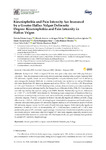Mostrar el registro sencillo del ítem
Kinesiophobia and Pain Intensity Are Increased by a Greater Hallux Valgus Deformity Degree- Kinesiophobia and Pain Intensity in Hallux Valgus
| dc.contributor.author | Palomo-López, Patricia | |
| dc.contributor.author | Becerro-de-Bengoa-Vallejo, Ricardo | |
| dc.contributor.author | Losa Iglesias, Marta Elena | |
| dc.contributor.author | López-López, Daniel | |
| dc.contributor.author | Rodríguez Sanz, David | |
| dc.contributor.author | Romero Morales, Carlos | |
| dc.contributor.author | Calvo-Lobo, César | |
| dc.contributor.author | Mazoteras-Pardo, Victoria | |
| dc.date.accessioned | 2020-02-03T17:08:04Z | |
| dc.date.available | 2020-02-03T17:08:04Z | |
| dc.date.issued | 2020-01 | |
| dc.identifier.citation | Palomo-López, P.; Becerro-de-Bengoa-Vallejo, R.; Losa-Iglesias, M.E.; López-López, D.; Rodríguez-Sanz, D.; Romero-Morales, C.; Calvo-Lobo, C.; Mazoteras-Pardo, V. Kinesiophobia and Pain Intensity Are Increased by a Greater Hallux Valgus Deformity Degree- Kinesiophobia and Pain Intensity in Hallux Valgus. Int. J. Environ. Res. Public Health 2020, 17, 626. | es_ES |
| dc.identifier.issn | 1660-4601 | |
| dc.identifier.uri | http://hdl.handle.net/2183/24815 | |
| dc.description.abstract | [Abstract] Background: Hallux valgus (HV) has been previously associated with psychological disorders. Thus, the purposes of this study were to associate kinesiophobia and pain intensity with HV deformity degrees, as well as predict kinesiophobia and pain intensity based on HV deformity and demographic features. Methods: A cross-sectional study was carried out recruiting 100 subjects, who were divided into HV deformity degrees, such as I-no HV (n = 25), II-mild (n = 25), III-moderate (n = 25), and IV-severe (n = 25) HV. Kinesiophobia total and domains (activity avoidance and harm) scores and levels were self-reported by the Tampa Scale of Kinesiophobia (TSK-11). Pain intensity was self-reported by the numeric rating scale (NRS). Results: Statistically significant differences (p < 0.01; η2 = 0.132–0.850) were shown for between-groups comparison of kinesiophobia total and domain scores (activity avoidance and harm) and levels, as well as pain intensity among HV deformity degrees. Post hoc comparisons showed statistically significant differences with a large effect size (p < 0.05; d = 0.85–4.41), showing higher kinesiophobia symptoms and levels and pain intensity associated with greater HV deformity degrees, especially for III-moderate and/or IV-severe HV deformity degrees versus I-no HV and/or II-mild deformity degrees. Both statistically significant prediction models (p < 0.05) for kinesiophobia (R2 = 0.300) and pain intensity (R2 = 0.815) were predicted by greater HV deformity degree and age. Conclusions: Greater kinesiophobia symptoms and levels and pain were associated with higher HV deformity degrees, especially severe and/or moderate HV with respect to no and/or mild HV. The kinesiophobia and pain intensity were predicted by greater HV deformity degree and age. | es_ES |
| dc.language.iso | eng | es_ES |
| dc.publisher | MDPI | es_ES |
| dc.relation.uri | https://doi.org/10.3390/ijerph17020626 | es_ES |
| dc.rights | Atribución 4.0 España | es_ES |
| dc.rights.uri | http://creativecommons.org/licenses/by/4.0/es/ | * |
| dc.subject | Chronic pain | es_ES |
| dc.subject | Hallux valgus | es_ES |
| dc.subject | Musculoskeletal diseases | es_ES |
| dc.subject | Psychology | es_ES |
| dc.title | Kinesiophobia and Pain Intensity Are Increased by a Greater Hallux Valgus Deformity Degree- Kinesiophobia and Pain Intensity in Hallux Valgus | es_ES |
| dc.type | info:eu-repo/semantics/article | es_ES |
| dc.rights.access | info:eu-repo/semantics/openAccess | es_ES |
| UDC.journalTitle | International Journal of Environmental Research and Public Health | es_ES |
| UDC.volume | 17 | es_ES |
| UDC.issue | 2 | es_ES |
Ficheros en el ítem
Este ítem aparece en la(s) siguiente(s) colección(ones)
-
GI-UDISAP - Artigos [186]






